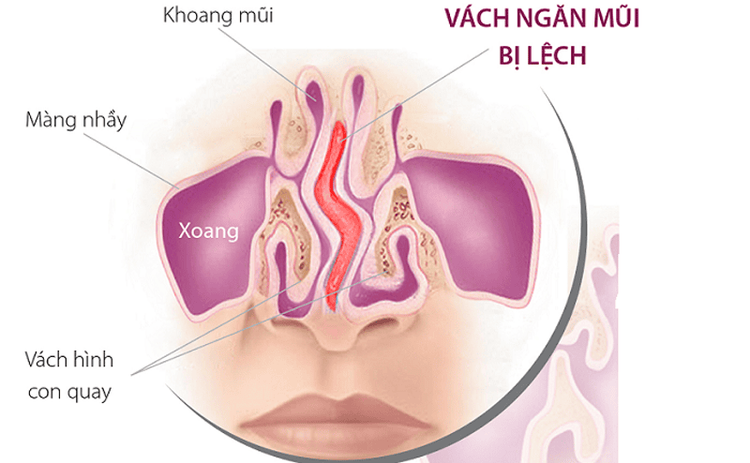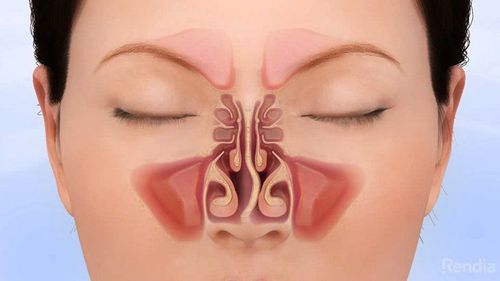This is an automatically translated article.
The article was professionally consulted by Specialist Doctor Ear, Nose Throat Doctor - Department of Medical Examination and Internal Medicine - Vinmec Ha Phong International Hospital.
About 80% of us have a deviated septum without knowing it. However, a normal deviated septum does not affect health, but if the condition is more severe, it can lead to especially serious health complications.
1. What is a deviated nasal septum?
Our nose is divided into 2 sides, separated by a “septum” called the nasal septum. This septum is made up of a piece of bone in the back and a piece of cartilage in the front. A deviated septum is when the septum is bent to one side, making one side of the nasal cavity smaller than the other, leading to breathing problems. Deviated nasal septum is classified into many types:
Simple deformity: Curved in the shape of a C, the septum is only crooked to one side (left or right). S-shaped curvature: A complicated nasal septum deformity, which can both be crooked to the left and can be crooked to the right.

Nasal septum spine or crest: A common phenomenon at the junction of the bone and cartilage of the septum. The spines or crests of the nasal septum can touch the nasal mucosa, causing bleeding and severe pain for the patient.
2. Causes of deviated nasal septum
There are actually many possible causes of a deviated nasal septum. In which, there are causes such as:
Congenital causes: some cases of deviated nasal septum occur during fetal development and are easily recognized soon after the baby is born. Injury to the nose: Consequences of trauma to the nose area can cause the septum to deviate to one side. For a young child, it may be due to a trauma during the mother's labor. For older children and adults, it can be due to daily life accidents, traffic accidents or violence... causing mechanical impact on the face and nose, leading to deviated septum. People who play sports that require a lot of interaction or drivers who do not wear seat belts are more susceptible to traumatic deviated septum. Aging process: Normal aging of the human body can also change the structure of the nose and deviate the nasal septum over time. Chronic inflammation of the nose, allergic rhinitis, sinusitis: Frequent nose strokes due to inflammation can change the structure of the septum, leading to a crooked nasal septum.
3. Identify deviated nasal septum
You can recognize a deviated septum by the following symptoms:
Nasal congestion: There are many people who have a deviated septum but do not have any symptoms at all. However, there are still cases of deviated septum causing nasal congestion on one or both sides on a regular basis, making it difficult for patients to breathe even without rhinitis. Nasal congestion can be worse when it is accompanied by respiratory infections such as common colds, flu or allergies to respiratory agents...

Nosebleed: Because the surface of the nasal septum is very thin, but it is the focus of many small blood vessels, the blood vessels are in a rather shallow position, so when the septum is crooked, the surface of the septum becomes drier, making it worse. increased risk of nosebleeds. Facial pain: Severe deformity of the septum causes blockage of one side of the nose, leading to a feeling of pain or pressure on one side of the face on the same side with nasal congestion. Noisy breathing during sleep: Due to the narrowing of one side of the nasal passage, the passage of air will cause noise, especially during sleep, which is more common in children than in adults. Tendency to sleep on their side: Because one side of the nose is narrow, some people tend to lie on their side only to make breathing easier. Nasal cycle: Alternating congestion between the two sides of the nose, when one side of the nose is blocked due to blood stasis in the bridge of the nose, the other side is open. This symptom is difficult to recognize, but if the patient clearly feels the nasal cycle, this is an abnormal phenomenon. Migraine headache, eye socket pain: It can be painful on the right or left side depending on which side of the nasal septum is crooked or it can hurt on both sides. Although the headache is not severe, it is dull and persistent, making the patient very uncomfortable. Headaches increase when the sun is hot or it's too cold, more pain in women during menstruation, making the patient irritable, irritable...
4. Treatment of deviated nasal septum

Medical treatment with drugs for a deviated septum is usually only treating the symptoms caused by the deviated septum (anti-nasal drugs, anti-inflammatory drugs, corticosteroids...).
Because deviated septum is a structural change, it is difficult for medical treatment to cure it. All of the above drugs only have the effect of reducing nasal congestion by reducing edema of the nasal mucosa but do not change the structure of the septum. Cases of deviated septum affect health and quality of life such as: causing nasal congestion, headaches, sinusitis, which is a trigger point for allergic rhinitis to have septal correction surgery.
Endoscopic nasal septum surgery to correct a straight septum and improve ventilation for the respiratory system is an endoscopic surgery performed at Vinmec International General Hospital. Accordingly, this technique has helped many patients bring the septum back to the correct position at the midline of the two sides of the nose, helping to equal ventilation on both sides of the nose, reducing the risk of rhinitis and inflammation. effective sinuses.
Please dial HOTLINE for more information or register for an appointment HERE. Download MyVinmec app to make appointments faster and to manage your bookings easily.











